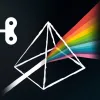Take a look inside 5 images
Light & Color by Tinybop
Pros: It's a curiosity-driven experience, and the AR feature is a neat way to bring exploration beyond the screen.
Cons: The lack of structure and background may turn some students off. No system for documenting learning or tracking what students are doing in the app.
Bottom Line: Free-play science-based exploration works best for students who love to discover things on their own with little guidance; others will need scaffolding.
Though students will mostly use Light & Color by Tinybop as free exploration, teachers will certainly want to check out the handbook for lots of background information on the scientific principles covered. All the foundational basics for informing what's going on in the free-play experimentation are there. Teachers will also find discussion questions to help round out learning. Having students document their experimentation and discoveries could also help them organize what they're doing and allow teachers to assess any learning taking place. Have students turn on the label feature to learn scientific vocabulary. Then, help make the connection to the real world. Teachers can create a separate user account for each student, though other than naming colors, there's little that students will do that needs to occur in a personalized account.
Light & Color by Tinybop offers open-ended experimentation to help students learn the scientific principles behind light and color. It's number 12 in Tinybop Explorer's Library, which is a series of apps dedicated to offering science learning platforms. Like all the apps in the series, Light & Color by Tinybop is completely exploration based: There are no instructions, no rules, and no games to complete. Rather, students take the lead in simply trying different things out to see what happens, such as moving the position of the sun during a rainstorm to see if they can create a rainbow. In the same activity space, they can experiment with different kinds of light passing through different objects (e.g., prism, opaque object). In a Mix section, students combine and separate paint or light colors to see what they can create. An AR feature allows students to collect, identify, name, match, and categorize colors they find in their own environment. Other activities let students see how vision looks different for a human, a dog, and a bee; sort colors by different rules such as spectrum, saturation, or tone; and assign emoticon faces to different colors. There are no instructions for play, but students can turn on labels to learn science vocabulary words in over 40 languages. A learning guide (English only) gives lots of background scientific information, tips for playing and experimenting in the app, and discussion questions.
Light & Color by Tinybop presents a welcoming environment where students can freely experiment with scientific concepts, though some may benefit from more structure. Just like all the apps in Tinybop's collection, Light & Color by Tinybop excels in using technology in clever and inventive ways. For example, students may marvel as the app analyzes and identifies the colors of objects around them. And as students experiment with what happens when different kinds of light, objects, or colors mix, they're in the driver's seat -- which is absolutely the best place to be for scientific inquiry and hands-on learning. For students who love science, or who have no problem throwing themselves into something without really understanding what they're doing, just to see what happens, Light & Color by Tinybop is great. It isn't as great for students who need a bit more structure.














